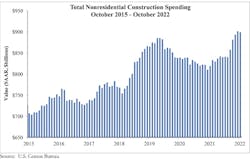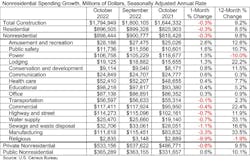U.S. Construction Spending Dips, But Remains Elevated
PRESS RELEASE
WASHINGTON DC, December 1, 2022 — Total construction spending decreased by 0.3% for the month of October, with downturns in homebuilding and most major nonresidential categories, according to an analysis the Associated General Contractors of America (AGC) released today of federal spending data.
Association officials noted contractors are struggling to complete projects as the number of open positions at the end of October topped hires in the month.
“Most nonresidential contractors report full order books but are having trouble hiring enough workers to keep projects on schedule,” said Ken Simonson, the association’s chief economist. “Rising interest rates and costs for materials are likely to choke off some projects but there will be plenty of infrastructure, manufacturing plants and renewable energy projects next year—if contractors can find enough workers to build them.”
Construction spending, not adjusted for inflation, totaled $1.795 trillion at a seasonally adjusted annual rate in October, 0.3% below the September rate but 9.2% above the October 2021 rate. Spending on private residential construction declined for the fifth-straight month in October, by 0.3%. Spending on private nonresidential construction fell 0.8% in October, while public construction investment slumped by 0.9%.
Residential spending was dragged down by a 2.6% plunge in single-family homebuilding, which swamped increases of 0.6% in multifamily construction and 2.0% in residential improvements. The largest nonresidential segment, commercial construction —comprising warehouse, retail, and farm construction— declined 0.4%. Among other large nonresidential categories, highway and street construction slid 0.7% and manufacturing construction tumbled 3.3%. In contrast, power construction climbed 1.5%.
Construction industry job openings totaled 377,000 at the end of October, which exceeded the 341,000 employees hired during the month, according to government data released on Wednesday. The gap implies contractors wanted to hire more than twice as many people as they were able to bring on board and most likely contributed to the decline in spending put in place, Simonson said.
Association officials said labor shortages remain one of the top concerns for most construction firms. They urged Congress and the administration to allow more immigrants with construction skills to enter the industry to provide short-term relief. But they maintained that the best way to resolve workforce shortages was to boost federal funding and support for construction-focused education and training programs.
“You can’t be both for infrastructure and against boosting investments in preparing workers to build that infrastructure,” said Stephen E. Sandherr, the association’s chief executive officer. “Until federal officials narrow the five-to-one gap in federal funding for college prep versus craft career development, labor shortages will restrain the industry’s ability to rebuild the economy.”
##########

